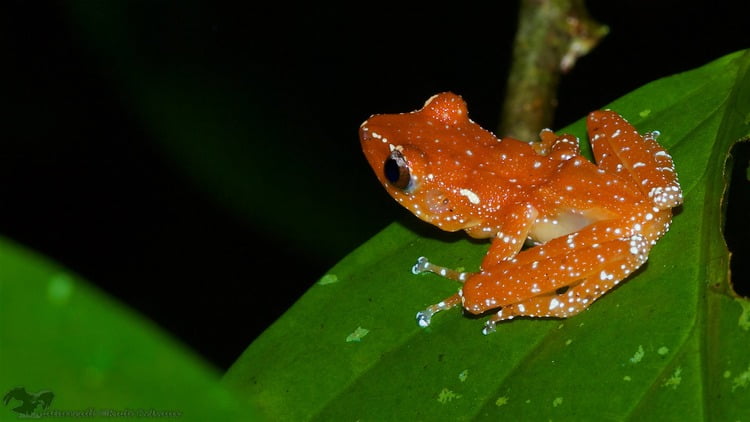Understanding Anura Responses to Rainforest Fragmentation and Oil Palm Agriculture
About
PhD Researcher: Juan Manuel Aguilar León
Supervisors: Michael Bruford, Benoît Goossens and Pablo Orozco-terWengel
Institution: Cardiff University
Status: Completed
Research questions:
The main aim of this project was to characterise the effects of palm oil agriculture (and other land conversion processes) and consequent forest fragmentation on anuran (here frog) diversity at different spatial scales in eastern Sabah.
Methods:
To assess these effects, we used a combination of species diversity and distribution analysis with a measure of evolutionary diversity using molecular methods and, on a smaller spatial scale, analysed the demographic processes occurring in and around palm oil-dominated fragmented landscapes using a combination of population genetic methods and ecological surveys.
Frog communities were surveyed across eastern Sabah to provide diversity comparisons between primary, fragmented and continuous forests, focusing on five sites each at the Tabin Wildlife Reserve, Deramakot Forest Reserve, and Kabili Sepilok Forest Reserve. Danum Valley and larger Lower Kinabatangan Wildlife Sanctuary (LKWS) forest fragments. Five transects were surveyed at each site, and key vegetation characteristics, species abundance, richness and endemism were estimated for forest restriction, plantation advantage and limited plantation penetration.
Intensive surveys were carried out within and among forest and oil palm sites within the LKWS. In addition, estimates of migration and gene-flow were undertaken for the most abundant species across the Sanctuary to compare and contrast estimates of genetic diversity within species. Analyses was carried out on three frog species (terrestrial specialist, plantation specialist and generalist).
Transect methods are routinely used to determine intraspecific and interspecific changes in amphibian populations within sites and across changing environmental features. Transects were established across the LKWS and were monitored and sampled on a regular basis during the fieldwork. The transects included three major habitat types: (1) Secondary forest fragments, (2) oil palm plantations and (3) edge habitat between forest and plantation. Transects were characterised using 13 habitat parameters of potential relevance for anuran populations (number of trees, mean and variance of tree diameter, number of logs, mean log diameter, canopy cover, variance in canopy cover, understory vegetation density (grid sampling), gradient, leaf litter cover and weight, green vegetation cover, number and width of streams, total length of all superficial water bodies and for oil palm plantations habitat, the age of palms will be recorded). Each transect was sampled at least twice during the rainy and dry seasons. Each transect was sampled for frogs during the period of maximum frog activity.
The visual encounter survey method (VES) of standardised transects was used to measure frog species richness and abundance within eleven habitat blocks of the LKWS. DNA sampling of frogs was done by buccal swabs DNA and extracted using a QIAgen DNeasy tissue kit (QIAgen) following the manufacturer’s protocol, with a few additional steps. Mitochondrial DNA barcoding was carried out for all species using a fragment of the cytochrome oxidase subunit I (COI) and the 16S ribosomal RNA genes to estimate phylodiversity among sites and regions, enabling an independent assessment of the evolutionary processes underlying frog assemblage structure in the region. Next generation sequence (NGS) was used to develop microsatellite markers to estimate genetic structure and diversity for each site in combination with statistical modelling to distinguish between historical, niche and neutral community processes.
To assess the effects of habitat type on the abundance (number of individuals), species richness (number of species) and diversity of anurans, a mix of several ecological techniques was used, including the Generalized Linear Mixed Model (GLMM). Patterns of frog community structure and composition were explored using non-metric multidimensional scaling (NMDS) ordination. To test for significant differences in the overall community structure between fragments and oil palm plantations, Analysis of Variance Using Distance Models (ADONIS) and correlation analysis were used. Genetic analysis such as genetic structure, gene flow, genetic diversity, demographic changes, phylogenetics and phylodiversity were also performed.
Expected outcomes:
Tropical rainforests are becoming increasingly fragmented due to anthropogenic landscape changes, and fragmentation has been an increasing threat to biodiversity in this ecosystem. Changes in natural habitats due to fragmentations affect individuals of different species in various ways, especially in the decrease of habitat availability, changes in spatial configuration and habitat quality of fragments. Therefore, empirical data on the ecological plasticity and sensitivity of a wide range of species are essential for effective conservation planning and formulation of management plans. The focus of recent studies addressing the consequences of habitat fragmentation on tropical biota have been mainly directed towards large mammals such as orangutans and elephants (Goossens et al. 2005; Estes et al. 2012). To date, very little is known about how amphibians cope with habitat fragmentations, and understanding the consequences of fragmentation is vital for the conservation of frog communities.
This project produced a combination of ecological data, species diversity, phylogenetic, phylogeographic and population genetic data, allowing us to expand our knowledge on frog conservation communities and to formulate adequate conservation plans related to fragmented habitats due to oil palm agriculture. As some amphibians are well-known as excellent biodiversity indicators, we were able to provide an overview of the current biodiversity level in the area.

